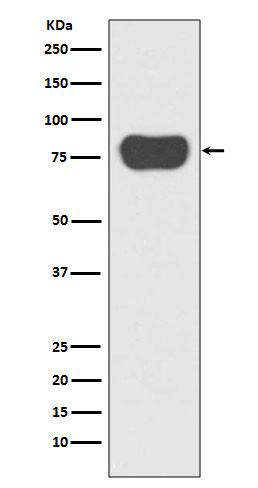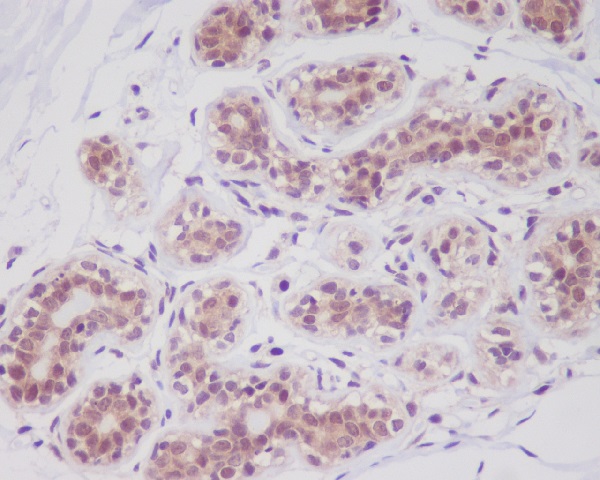

| WB | 1/500-1/1000 | Human,Mouse,Rat |
| IF | 1/20 | Human,Mouse,Rat |
| IHC | 1/50-1/100 | Human,Mouse,Rat |
| ICC | 1/50-1/200 | Human,Mouse,Rat |
| FCM | 1/50-1/100 | Human,Mouse,Rat |
| Elisa | 咨询技术 | Human,Mouse,Rat |
| Aliases | CTTN; EMS1; Src substrate cortactin; Amplaxin; Oncogene EMS1 |
| Entrez GeneID | 2017 |
| WB Predicted band size | Calculated MW: 62 kDa; Observed MW: 80 kDa |
| Host/Isotype | Rabbit IgG |
| Antibody Type | Primary antibody |
| Storage | Store at 4°C short term. Aliquot and store at -20°C long term. Avoid freeze/thaw cycles. |
| Species Reactivity | Human,Mouse,Rat |
| Immunogen | A synthesized peptide derived from human Cortactin |
| Formulation | Purified antibody in PBS with 0.05% sodium azide. |
+ +
以下是关于Cortactin抗体的3篇代表性文献摘要概括:
1. **文献名称**:*Cortactin regulates actin dynamics by stabilizing the Arp2/3 complex*
**作者**:Weed SA, et al.
**摘要**:该研究利用Cortactin抗体验证其在细胞迁移中的作用,发现Cortactin通过结合Arp2/3复合体促进肌动蛋白分支结构形成,增强细胞伪足(lamellipodia)的稳定性,从而影响肿瘤细胞的侵袭能力。
2. **文献名称**:*Cortactin phosphorylation regulates cell invasion through matrix metalloproteinases*
**作者**:Wu H, et al.
**摘要**:通过特异性Cortactin抗体分析磷酸化位点,研究发现Src激酶介导的Cortactin磷酸化可激活基质金属蛋白酶(MMPs),促进肿瘤细胞外基质降解,为癌症转移提供分子机制依据。
3. **文献名称**:*Cortactin overexpression suppresses EGFR degradation and promotes EMT*
**作者**:Ohoka Y, Takahashi M.
**摘要**:利用免疫沉淀(IP)和Western blot技术,证明Cortactin过表达通过抑制表皮生长因子受体(EGFR)内吞降解,促进上皮-间质转化(EMT),这一过程与侵袭性乳腺癌密切相关。
4. **文献名称**:*Cortactin as a diagnostic marker in head and neck squamous cell carcinoma*
**作者**:头越文夫, 等.
**摘要**:通过免疫组化(IHC)结合Cortactin抗体,研究发现Cortactin在头颈部鳞癌中高表达,且与淋巴结转移和不良预后显著相关,提示其作为潜在诊断标志物的价值。
注:以上内容为文献核心结论的概括,实际引用时需核对原文信息(期刊、年份等)。
Cortactin is a dynamic cytoskeletal protein encoded by the *CTTN* gene, primarily involved in regulating actin polymerization, cell migration, and membrane dynamics. It interacts with the Arp2/3 complex to promote actin branching, a critical process in cellular protrusions like lamellipodia and invadopodia. Cortactin also participates in endocytosis, vesicle trafficking, and receptor signaling. Its activity is modulated by post-translational modifications (e.g., phosphorylation, acetylation) and overexpression is linked to cancer progression, metastasis, and therapeutic resistance.
Cortactin antibodies are essential tools for studying its expression, localization, and function in physiological and pathological contexts. Commonly used in techniques like Western blotting, immunofluorescence, and immunohistochemistry, these antibodies target specific epitopes or phosphorylation sites (e.g., Tyr421) to assess activation states. Researchers employ cortactin antibodies to explore roles in diseases such as carcinomas, neurological disorders, and infections, where pathogens like *Listeria* exploit cortactin for intracellular motility.
Commercial cortactin antibodies vary in host species (e.g., mouse, rabbit), clonal specificity (e.g., 4F11), and reactivity across human, mouse, or rat samples. Validation for specificity, cross-reactivity, and batch consistency is crucial due to potential isoforms (e.g., cortactin-like protein) and homologous sequences. Ongoing studies using these antibodies continue to unravel cortactin's dual roles as a oncogenic driver and a regulator of normal cellular homeostasis.
×